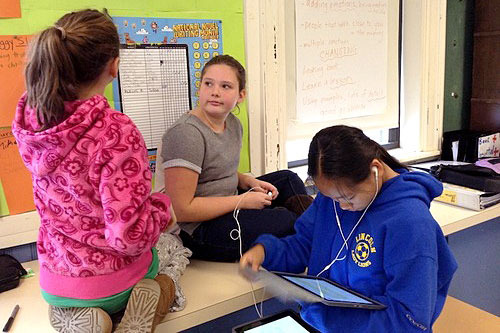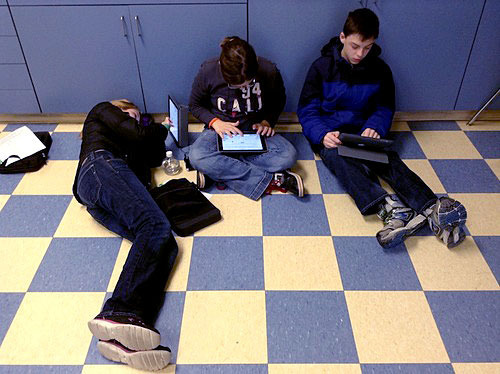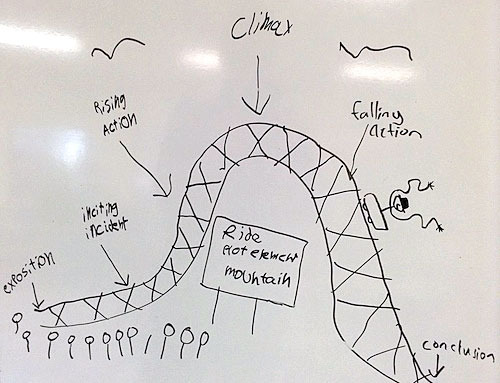Stories of Tomorrow: How to Open Doors to Imagination in the Classroom

Tomorrow’s stories start in all sorts of places: on the drive to work, or at the movie theater. One constant source of inspiration? The classrooms that tackle NaNoWriMo through our Young Writers Program. YWP educator Alexis Lyon talks about incorporating YWP into her class curriculum.
I first saw NaNoWriMo’s Young Writers Program from a student teacher at Lincoln Middle School. My mentor also had the YWP progress chart hanging in the classroom for students who were participating in it outside of the classroom. The next year, as I was developing the curriculum for my own classroom, I decided to incorporate the Young Writers Program into my own lessons.
The program was such a success for my 6th grade class. I teach students in a two year loop, so I knew without a doubt that I would run the program with the same students in 7th grade. I had students asking me if we were going to do it again. They wrote so much and were so excited the first year, so I had a lot of momentum and new ideas for how to incorporate it into my curriculum again.
I think the hardest part of running the Young Writers Program is incorporating it into my curriculum plan for the year, though. With that said, I work with an amazing team of teachers who are willing to collaborate across curriculum, and I was able to combine my classes with the social studies teacher next door to have an all day Write-a-thon.
Other obstacles I ran into were related to technology. Students loved to see their word count in real time, and to keep going back to the site to update their progress or use the fun tools. I didn’t always have enough working laptops for the class, and sometimes it was hard to access the site either because of our school Wi-Fi, or the extreme volume of students logging into the NaNoWrimo site all over the world at once. We always had paper notebooks as backup though, and some students wrote on paper the whole month by choice.
I asked a student (Matthew Davis, now grade 7) if he thought there were obstacles. He thought, “Not really. When I was thinking about a topic, it came to me. It was like opening a door to imagination. You can write about anything!”
At the beginning of 6th grade I had a student that could piece together about 3/4 of a page of writing in a couple weeks. By her second year of NaNo (7th grade), she had 34 pages of fiction written in just one month!

My student, Matthew Davis, told me what surprised him most, “I did get a chance to finish it. It was fun trying to achieve that goal. I met my estimated words goal. When you meet that goal or go above that, it feels amazing. When you keep on writing, it just flows.”
I think that my favorite thing in general about running the Young Writers Program was how excited my students were to write. As an ELA (English Language Arts) teacher, it is absolutely wonderful to have students come to class eagerly asking, “Are we going to write today?
Matthew explained, “It was one of those things you never thought you would be able to do. Finding the time to write… I had a bunch of time on my hands. Every day I would write one to two paragraphs. I started looking for more time to write because I was having so much fun with it. When you have to write something you don’t like, you try to avoid it, but I really liked my topic. It was really cool that you could write about anything.”
During NaNoWriMo, I worked all sorts of plot lessons into the curriculum, both of my own creation, and from the Young Writers Workbook. I loved being able to have students consistently refer to their own writing to make sense of concepts such as the elements of plot and character development.

This year, with my 7th grade students participating for the second year in a row, I got to see such huge increases in both the quantity and quality of my student’s writing. In December, students used iPads to make book trailers of their own books. Some published their writing on Wattpad. We posted a list in the classroom of student books that were published online so that other students could read them during independent reading time. In a later unit in the spring, some of my students chose to turn their NaNoWriMo content into graphic novels. The Young Writers Program helped my students to really see themselves as actual writers, with stories to tell that could be read far and wide.
A few final words from Matthew: “I liked everything about NaNoWriMo. I really like how they just kind of opened it up. It gave me new writing techniques. It opened up different ideas for me. Now ideas come to me quicker. If I have to find a new topic, I feel like I can make a new beginning. I’m just glad I got the opportunity to do it, especially the second time around.”

Alexis Lyon teaches 6th and 7th grade English Language Arts at Lincoln Middle School in Portland, Maine. Her educational background includes degrees in Asian Studies and Ceramics. She has taught environmental education, low impact backpacking, and ceramic sculpture to students of all ages. When not teaching, you can likely find her in the waters and mountains of New England, surfing and snowboarding.
Chris Baty's Blog
- Chris Baty's profile
- 63 followers



